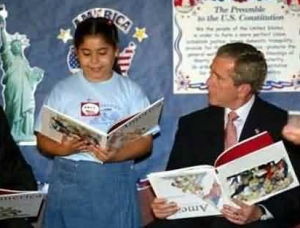By Manuel Barrera
The Department of Education (ED) Public Submission: Comment on FR Doc # 2014-28218 is a comment section at Regulations.gov, The #USDOE is requesting comments on proposed “regulations under title II of the Higher Education Act of 1965 (HEA)” that govern teacher education so as to provide guidance on providing aid to students seeking to become teachers under the Teacher Education Assistance for College and Higher Education (TEACH) Grant Program under title IV of the HEA”.
These new regulations are being proposed in the context of continued support to the failed “No Child Left Behind Act” (Elementary and Secondary Education Act, ESEA/NCLB) that, if passed, will continue the use of standardized testing based on meeting “Common Core” curriculum standards. The failure of standardized testing to bring anything but continued inequity and disparity in educational achievement for the most impoverished students is now to be written into the expectations for preparing new teachers. The new regulations reinforce what has already been apparent about public schools for decades; continued segregation in educational achievement, continued promotion of preparing teachers racially disparate from the students they teach, and continued privatization of what constitutes educational “success” for the sake of reducing the profession of teaching to a clerical administration of substandard curriculum for substandard and segregated educational outcomes.
The reauthorization of ESEA/NCLB and the new regulations for teacher preparation in the HEA seek to continue the failed strategy–if public education is indeed aimed at creating an educated people–of “accountability” and “standards-driven” education initiated since the publication of the 1983 “Nation At Risk” that resulted in the creation of state systems of high stakes testing for students and the credentialing of teachers. The results of standards and accountability, as defined by successive Democratic and Republican administrations, has been the continued downgrading of student academic achievement, increasing gaps in that achievement between affluent and poor or working class communities, and continued degeneration in the social, academic, and critical literacy among successive generations of students, youth, and the workforce that they have joined.
In truth, there is only one form of accountability that children and youth require; to learn to love what they learn. There are only two standards that a teacher must meet and meet with excellence; Do No Harm and Employ Democracy in the Search for the Truths of This World.
The standards that matter for aspiring new teachers are to
Learn all you can about the world and how best to share what you’ve learned with others;
Teach what you love;
Understand the Students in Front of You and Help Them To Make This World a Better Place.
Below is what I sent as commentary sent 1/30/2015:
I oppose both the intent and context of “accountability” that the current federal and state administrations have used historically to undermine the development of a diverse teacher workforce prepared to reduce decades of educational disparity in the graduation of public school students and their preparation either for the world of work or postsecondary education. In fact, the provisions in the ESEA for continued testing and reduction of pupil education to a set of “common core” standards place the most vulnerable students in public schools at risk and provide little evidence of teaching effectiveness as a result.
First, the very premise of current accountability in the U.S. and in Minnesota is based on the false notions of educational “reform”. “Educational accountability” is really a program that places blame on teachers for governmental failures in school funding, racial disparities in employment, housing, and, indeed, the continued proliferation of disproportionately White teacher workforces. As one of my colleagues has written, The ESEA “requires that states work to change the disproportionate overrepresentation of inexperienced teachers in high-need schools (PL 107- 110, Section 1111(b) (8) (C)). Yet these proposed regulations would promote that very practice by incentivizing preparation programs that aren’t focused on urban education to place first-year teachers in high-need schools (NPRM, p. 71286).” The regulations contradict each other in seeking to place new teacher candidates in “better performing” schools as part of their preparation and then propose these same graduates get placed in “high need” schools. This sort of logic seems naïve at best given that “better performing” schools—typically primarily White affluent schools—are neither equivalent to “high need” schools—typically schools in Black, Brown, and low income communities—nor is the preparation required to educate students in “high need” communities at all similar given the needed additional components to promote literacy among children, youth, and communities historically struggling with literacy, the necessary knowledge base, and technological capacity inherent in very poor neighborhoods and schools.
Second, there is a reason why the teacher workforce is predominantly White. It is because the beneficiaries of our education system, especially the public education system, are predominantly White. Poor, urban students of color have historically ill-benefited from a public education system that sees them, our neighborhoods, their parents, even our history as limited and unworthy to be other than a “headcount” for public school funding or to be ignored of our communities’ legacies of struggle for a public education that can bring the promise of access to meaningful employment and an educated people who can achieve greater equality of outcomes. The proposed ESEA provisions limit even further the already limited access to student financial aid, which affect most acutely low-income people of color, especially students who come from working families with limited financial resources even to attempt college never mind complete teacher certification.
The host of obstacles to people of color and working people as a whole include not simply lack of resources, but, as indicated above the substandard level of education they receive that is required to participate equitably in higher education such as seeking teacher licensure. The most egregious form such inequity takes is the immense disparity in taking irrelevant—to teaching effectiveness—privatized educational testing that have resulted in major disparities between White and/or affluent teacher candidates and their peers of color that come to school with substandard preparation to participate in college from inception (cf. Hawkins, Nehil, & Palazzolo, 2015); all because of the substandard level of education based on educational standards of false “accountability”. There are reams of scholarly writings that illustrate this pattern. Here are a few:
Cordray, Pion, Brandt, Molefe, and Toby, 2012. The Impact of the Measures of Academic Progress (MAP) Program on Student Reading Achievement (ERIC Document ED537982)
French, 2003, Middle School Journal “A New Vision of Authentic Assessment to Overcome the Flaws in High Stakes Testing”
Betts & Grogger, 2003, The Impact of Grading Standards on Student Achievement, Educational Attainment, and Entry-Level Earnings. Economics of Education Review, Elsevier, vol. 22(4), pages 343-352, August.
Finally, most of the provisions of the proposed ESEA reinforce what has long been the basis for failure of our public schools to educate equitably the diverse population of children and youth of our country; a focus on poorly designed systems of student and teacher evaluation, a focus on the least common denominators constituting an education for any students but for whom students of color will be most affected given the racial and class disparities between “high performing” and “high need” schools, a focus on reinforcing limited and inequitable learner outcomes—community college for training a workforce run by corporations and a higher form of education for the sons and daughters of corporate elites and those “fortunate” enough to gain the favor of the affluent in our society.
These are significant problems with this proposed ESEA. It is far easier to see and speak to the problems because the solutions would require much more than a set of demands or of “good ideas”. Resolving the crisis of public education will require first and foremost an end to the framework of teaching and learning based on “accountability” as defined by educational privateers seeking to improve corporate profit-taking through publishing standardized tests and “common core” curricula.
The reason that this kind of false accountability and standards is a failure is because such accountability and standards presume there is a “bottom line” to producing an educated person. However, an education is not a set of standards and teaching effectiveness is not a minimal approach that delivers knowledge and skill like a component needed to produce an automobile or computer. An education is first and foremost the ability to see the world for what it is and determine how best it can be made better; all in participation and cooperation with every human being in society. Teaching effectiveness is first and foremost demonstrated not by how high a student can attain an irrelevant test score, but whether student in front of you knew one thing about the world before you started teaching and were able to demonstrate a fuller understanding of the world as a result of what you as a teacher did. Such a form of education requires much more engagement of communities, parents, and, most important, students and their teachers.
A very long time ago we learned that “separate but equal” was inherently unequal (Brown v. Board of Ed. 1954). Later, we learned that “equal” treatment can also be inherently unequal (Lau v. Nichols, 1974). The promise of these historic landmark educational rulings has yet to be realized. Indeed, today, these two precepts have severely been compromised with the advent of schooling that is tacitly segregated by community and the advent of education attempted to be “equalized” through standardized testing, common core standardization of learning, and the resulting homogenization of teacher workforce and the curriculum/intellectual expectations such teachers are expected to deliver. We need an act that promotes the freedom of teachers to teach what they love about learning, what their students need to participate and improve upon this world, and what our communities can learn how to effect the changes needed to overcome the legacies of poverty, racism, sexism, and war as a poor solution to conflict.
I urge the enactment of legislation that promotes actual learning and bans standards; promotes teaching on the basis of what teachers best know—what makes them educated—in contrast to evaluating them for conformity as a false accountability; and that projects a system of education that seeks the democratic participation of an educated people in all aspects of society with knowledge and skill that can critically determine how all people may benefit.
About the Author:
Manuel Barrera is Associate Professor of Urban Education at the Metropolitan State University in St. Paul, Minnesota. He has been involved in the struggle for a better world since age 7 when he stood to defend his two friends, the Jacksons, the lone African American boys in a southern Texas town; when he saw the world as it is and vowed to fight to make it what it should be.



